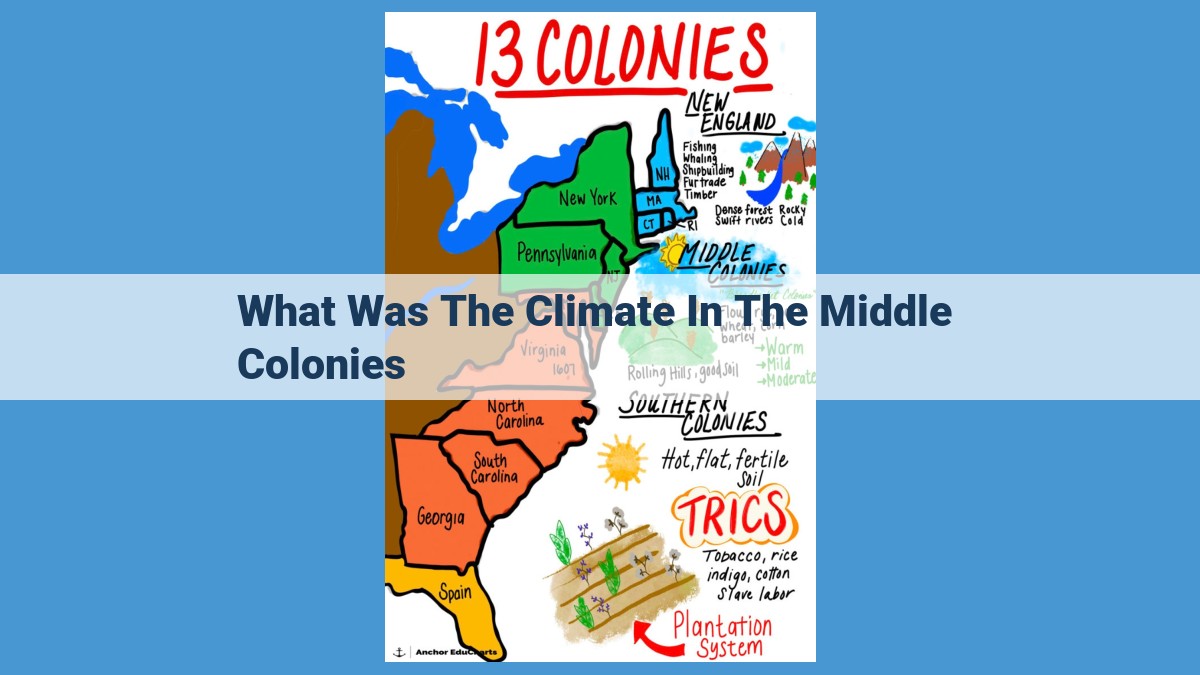The Middle Colonies enjoyed a moderate climate characterized by mild temperatures, ample precipitation, and distinct seasons. Summers were warm and humid, while winters were cold with moderate snowfall. The growing seasons were long and reliable, allowing for a diverse range of agricultural pursuits. This favorable climate played a pivotal role in the development of farming and the establishment of thriving settlements in the region.
The Allure of Moderate Climes: A Haven for Life and Cultivation
A moderate climate, characterized by its pleasant, seasonal changes and moderate temperatures, offers an ideal setting for human habitation and agricultural prosperity. Unlike harsh, extreme climates, moderate regions provide a balance of warmth and coolness, supporting a diverse range of life forms and enabling year-round cultivation.
The Middle Colonies, nestled between the harsh winters of the North and the sweltering summers of the South, epitomize the benefits of a moderate climate. Average temperatures hover around comfortable ranges, with seasonal variations that allow for both outdoor activities and crop growth. Growing seasons are extended, enabling farmers to cultivate a wide variety of crops that thrive in the temperate conditions.
Precipitation patterns are also moderate, providing adequate moisture for plant growth without excessive flooding or drought. Winters are characterized by occasional snow and temperatures that rarely drop below freezing, while summers offer warm, sunny days and refreshing evenings. This pleasant climate has played a crucial role in the historical and economic development of the Middle Colonies, attracting settlers and fostering a thriving agricultural industry.
Moderate Climate in the Middle Colonies
Nestled along the eastern coastline of North America, the Middle Colonies enjoyed a moderate climate that played a pivotal role in shaping its history and prosperity. This climate, characterized by mild temperatures and ample precipitation, provided an ideal setting for human habitation and flourishing agriculture.
Seasonal Symphony
Average temperatures in the Middle Colonies exhibited distinct seasonal variations. Winters brought crisp temperatures, averaging around the freezing point. Snowfall was moderate, ensuring a picturesque winter landscape. In contrast, summers were warm, with average temperatures hovering in the low to mid-80s Fahrenheit.
Extended Growing Season
The prolonged growing seasons were a boon to agriculture. Spring arrived early, allowing farmers to plant crops in March or April. The warm summers provided ample sunlight and moisture for crops to thrive. The growing season typically lasted until late October or November.
Abundant Precipitation
Precipitation was plentiful and well-distributed throughout the year. Rainfall was common in all seasons, ensuring a reliable supply of water for crops. The occasional thunderstorm provided vital moisture during the summer months.
Winters of Contrasts
Winters in the Middle Colonies were variable. Some winters brought harsh conditions, with biting cold and heavy snowstorms. Other winters were milder, with temperatures hovering above freezing and minimal snowfall. These fluctuating conditions kept the region’s inhabitants on their toes.
Summer Sunshine
Summers were marked by abundant sunshine and moderate humidity. Average temperatures in July and August reached the high 70s to low 80s Fahrenheit. The occasional heatwave brought temporary discomfort, but these spells were typically short-lived.
The Bountiful Harvest: Moderate Climate and Agriculture in the Middle Colonies
The moderate climate of the Middle Colonies played a pivotal role in shaping the thriving agricultural landscape that sustained both human populations and economic prosperity. With its temperate temperatures, abundant rainfall, and long growing seasons, this region became a fertile hub for a wide range of crops and livestock.
The mild winters and warm summers allowed for a year-round cultivation of crops, extending the harvest season and increasing agricultural productivity. Winter wheat, rye, and barley thrived in the cool fall and mild winters, while spring and summer crops such as corn, tobacco, and cotton flourished in the warm, humid climate.
The rich soil and reliable rainfall further enhanced agricultural yields. Farmers adopted innovative techniques such as crop rotation and fertilizer application to maximize soil fertility and boost production. Cattle, hogs, and sheep grazed on lush pastures, providing meat, wool, and dairy products.
The diverse agricultural industries that emerged in the Middle Colonies played a critical role in the region’s economic development. Surplus crops were traded with other colonies and exported to markets abroad, generating wealth and prosperity. This vibrant agricultural landscape became the foundation for the bustling cities and thriving economies that characterized the Middle Colonies.
Historical and Ecological Significance of Moderate Climate
Influence on Settlement Patterns and Economic Development
A moderate climate in the Middle Colonies played a pivotal role in shaping settlement patterns and economic development. The favorable conditions fostered human habitation and agriculture, attracting colonists to establish thriving communities. The predictable seasons allowed for organized farming, providing a reliable food source and supporting economic growth. Settlements flourished along rivers and coastlines, ensuring access to transportation and trade routes.
Understanding the Interplay between Climate and Human Activity
The moderate climate shaped the interactions between humans and their environment. Agriculture flourished in the fertile soils and ample rainfall, leading to the development of diverse agricultural industries. Farmers adapted their cultivation practices to the climate’s seasonal variations, ensuring optimal crop yields. The abundance of natural resources supported industries such as fishing, forestry, and shipbuilding, contributing to the economic prosperity of the colonies.
Implications for Present-Day Climate Change and Ecological Studies
The historical significance of the moderate climate in the Middle Colonies holds valuable insights for present-day climate change and ecological studies. By examining the relationship between climate and human activities, we gain a deeper understanding of the potential impacts of climate change on society and ecosystems. Historical records and data provide a baseline against which current climate patterns can be compared, helping scientists assess changes in temperature, precipitation, and extreme weather events. These insights can inform policy-making and climate adaptation strategies, ensuring a sustainable future.
